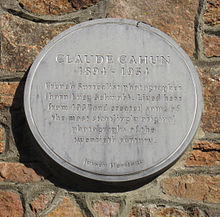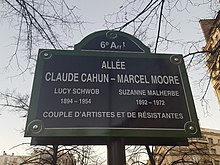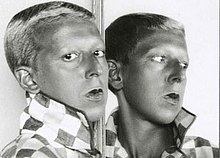|
Claude Cahun
Claude Cahun (French pronunciation: [klod ka.œ̃], born Lucy Renee Mathilde Schwob;[2] 25 October 1894 – 8 December 1954) was a French surrealist photographer, sculptor, and writer.[3] Schwob adopted the pseudonym Claude Cahun in 1914.[4] Cahun is best known as a writer and self-portraitist, who assumed a variety of performative personae. In her writing, Cahun mostly referred to herself with grammatically feminine words,[5] but she also said that her actual gender was fluid. For example, in Disavowals, Cahun writes: "Masculine? Feminine? It depends on the situation. Neuter is the only gender that always suits me."[6] Cahun is most well known for her androgynous appearance, which challenged the strict gender roles of her time. During World War II, Cahun was also active as a resistance worker and propagandist, founding the leftist group Contre Attaque, a union of communist writers, artists and workers, alongside André Breton and Marcel Moore.[7] Early lifeCahun was born in Nantes in 1894,[8] into a well-off literary Jewish family.[9] Avant-garde writer Marcel Schwob was her uncle and Orientalist David Léon Cahun was her great-uncle. When Cahun was four years old, her mother, Mary-Antoinette Courbebaisse, began suffering from mental illness, which ultimately led to her mother's permanent internment at a psychiatric facility.[10] In her mother's absence, Cahun was brought up by her grandmother, Mathilde.[11] Cahun attended a private school (Parsons Mead School) in Surrey after experiences with antisemitism at high school in Nantes.[12][13] She attended the University of Paris, Sorbonne.[12] She began making photographic self-portraits as early as 1912 (aged 18), and continued taking images of herself throughout the 1930s. Around 1914, she changed her name to Claude Cahun, after having previously used the names Claude Courlis (after the curlew) and Daniel Douglas (after Lord Alfred Douglas). During the early 1920s, she settled in Paris with lifelong partner Suzanne Malherbe, who adopted the pseudonym Marcel Moore.[14]: 70 The two became step-sisters in 1917 after Cahun's divorced father and Moore's widowed mother married, eight years after Cahun and Moore's artistic and romantic partnership began.[15] For the rest of their lives together, Cahun and Moore collaborated on various written works, sculptures, photomontages and collages. The two published articles and novels, notably in the periodical Mercure de France, and befriended Henri Michaux, Pierre Morhange, and Robert Desnos. Around 1922 Cahun and Moore began holding artists' salons at their home. Among the regulars who would attend were artists Henri Michaux and André Breton and literary entrepreneurs Sylvia Beach and Adrienne Monnier.[16] Work Cahun's works encompassed writing, photography, sculpture and theatre, of which the most remembered are the highly staged self-portraits and tableaux that incorporated the visual aesthetics of Surrealism. During the 1920s, Cahun produced an astonishing number of self-portraits in various guises such as aviator, dandy, doll, body builder, vamp and vampire, angel, and Japanese puppet.[14]: 67 Cahun gave a unique perspective within surrealism, using mirrors, collages and doubling in her photos to reflect the diversion from social norms. Some of Cahun's portraits feature the artist looking directly at the viewer, head shaven, often revealing only head and shoulders (eliminating body from the view), and a blurring of gender indicators and behaviors which serve to undermine the patriarchal gaze.[17][18] For example; in one photo Cahun is seen in a top that reads 'i am in training, do not kiss me.' showing how her identity and gender is allowed to be seen but should not be objectified and exoticized by the male gaze. Scholar Miranda Welby-Everard has written about the importance of theatre, performance, and costume that underlies Cahun's work, suggesting how this may have informed the artist's varying gender presentations.[19] Cahun's published writings include "Heroines", (1925) a series of monologues based upon female fairy tale characters intertwined with witty comparisons to the contemporary image of women; Aveux non avenus, (Carrefour, 1930) a book of essays and recorded dreams illustrated with photomontages; and several essays in magazines and journals.[20] In 1932, Cahun joined the Association des Écrivains et Artistes Révolutionnaires, where she met André Breton and René Crevel. Following this, Cahun began associating with the surrealist group and later participated in a number of surrealist exhibitions, including the London International Surrealist Exhibition (New Burlington Gallery) and Exposition surréaliste d'Objets (Charles Ratton Gallery, Paris), both in 1936. Cahun's photograph from the London exhibition of Sheila Legge standing in the middle of Trafalgar Square, her head obscured by a flower arrangement and pigeons perching on her outstretched arms, appeared in numerous newspapers and was later reproduced in a number of books.[21][22] In 1934, Cahun published a short polemic essay, Les Paris sont Ouverts, and in 1935 took part in the founding of the left-wing anti-fascist alliance Contre Attaque, alongside André Breton and Georges Bataille.[23] Breton called Cahun "one of the most curious spirits of our time."[24] In 1994, the Institute of Contemporary Arts in London held an exhibition of Cahun's photographic self-portraits from 1927 to 1947, alongside the work of two young contemporary British artists, Virginia Nimarkoh and Tacita Dean, entitled Mise en Scene. In the surrealist self-portraits, Cahun represented herself as an androgyne, nymph, model, and soldier.[25] In 2007, David Bowie created a multi-media exhibition of Cahun's work in the gardens of the General Theological Seminary in New York. It was part of a venue called the Highline Festival, which also included offerings by Air, Laurie Anderson, and Mike Garson. Bowie said of Cahun:
Collaboration with Marcel MooreCahun's work was often a collaboration with Marcel Moore (the pseudonym of Suzanne Malherbe).[27] It is believed that they were lovers with Moore being an integral part of Cahun's creative and playful process,[27] though this often goes unrecognized. It is believed that Moore was often the person standing behind the camera during Cahun's portrait shoots and was an equal partner in Cahun's collages.[17] With the majority of the photographs attributed to Cahun coming from a personal collection, not one meant for public display, it has been proposed that these personal photographs allowed for Cahun to experiment with gender presentation and the role of the viewer to a greater degree.[17] World War II activismIn 1937 Cahun and Moore settled in Jersey. Following the fall of France and the German occupation of Jersey and the other Channel Islands, they became active as resistance workers and propagandists. Fervently against war, the two worked extensively in producing anti-German fliers. Many were snippets from English-to-German translations of BBC reports on the Nazis' crimes and insolence, which were pasted together to create rhythmic poems and harsh criticism. They created many of these messages under the German pseudonym Der Soldat Ohne Namen, or The Soldier With No Name, to deceive German soldiers that there was a conspiracy among the occupation troops.[28] The couple then dressed up and attended many German military events in Jersey, strategically placing their pamphlets in soldier's pockets, on their chairs, and in cigarette boxes for soldiers to find. Additionally, they inconspicuously crumpled up and threw their fliers into cars and windows. On one occasion, they hung a banner in a local church which read "Jesus is great, but Hitler is greater – because Jesus died for people, but people die for Hitler." As with much of Cahun and Moore's artistic work in Paris, many of their notes also used this same style of dark humor. In many ways, Cahun and Moore's resistance efforts were not only political but artistic actions, using their creative talents to manipulate and undermine the authority which they despised. In many ways, Cahun's life's work was focused on undermining a certain authority; however, their activism posed a threat to their physical safety. As historian Jeffrey H. Jackson writes in his definitive study of their wartime resistance Paper Bullets, for Cahun and Moore, "fighting the German occupation of Jersey was the culmination of lifelong patterns of resistance, which had always borne a political edge in the cause of freedom as they carved out their own rebellious way of living in the world together. For them, the political was always deeply personal."[29] In 1944, Cahun and Moore were arrested and sentenced to death, but the sentence was never carried out, as the island was liberated from German occupation in 1945.[23] However, Cahun's health never recovered from her treatment in jail, and she died in 1954. Cahun is buried in St Brelade's Church with partner Moore. At the trial, Cahun said to the German judge (according to the documentary on the Occupation of the Channel Islands, presented by John Nettles) that the Germans would have to shoot her twice, as she was not only a Resister but a Jew. This apparently brought a peal of laughter from the court and is said to have been one reason the execution was not carried out.[30] Social critique and legacy Cahun made work for herself and did not want to be famous.[31] Cahun's work was largely unrecognized until 40 years after her death. In many ways, Cahun's life was marked by actions which revolted against convention, and her public image has since become a commentary which challenges the public's notions of gender, beauty, and logic.[citation needed] Her work was meant to unsettle the audience's understanding of photography as a documentation of reality. Furthermore, her poetry challenged gender roles of the time and attacked the increasingly modern world's social and economic boundaries. Also, Cahun's participation with the Parisian Surrealist group brought an element of diversity to the group's output which ushered in new representations. Most Surrealist artists were men, whose primary images of women depicted them as isolated symbols of eroticism rather than as the chameleonic, gender non-conforming figure that Cahun presented. Cahun’s photographs, writings, and general life as an artistic and political revolutionary continues to influence artists.[32][33] Twenty-first century writing on Cahun and Moore’s work has described the pair as "prototransgender artists".[34] Christy Wampole connects Cahun’s adopted name and appearance to twenty-first century genderqueer identities, arguing that Cahun's photographs display “transgender signals” and are a prototype of modern trans self-representation.[35] Cahun's collected writings were published in 2002 as Claude Cahun – Écrits (ISBN 2-85893-616-1), edited by François Leperlier.  In 2018, a street of Paris took the name of "Allée Claude Cahun – Marcel Moore"[36] (area of Saint-Germain-des-Prés – Montparnasse, near the rue Notre-Dame-des-Champs where Claude and Suzanne lived). Rupert Thomson's 2018 novel, Never Anyone But You, was based on the lives of Cahun and Moore in Paris and Jersey. It was favourably reviewed by Adam Mars-Jones in the London Review of Books.[37] Cahun and Moore's WWII activism and heroism are documented by Jeffrey H. Jackson in the 2020 book, Paper Bullets: Two Artists Who Risked Their Lives to Defy the Nazis.[38] Google honored Claude Cahun by showing an animated Doodle on its home page in many countries on 25 October 2021, on the anniversary of what would have been her 127th birthday.[39][40] Exist Otherwise is a literary journal edited by Eric Jennings that takes Claude Cahun as its literary inspiration.[41] Kaz Rowe, an illustrator, published a biography in graphic novel form on Cahun's life in 2023. Liberated: The Radical Art and Life of Claude Cahun explores Cahun's and Moore's involvement in "a radical journey of Surrealist collaboration that would take them from conservative provincial France to the vibrancy of 1920s Paris to the oppression of Nazi-occupied Jersey during World War II, where they used art to undermine the Nazi regime."[42][43] An opera about the lives of Cahun and Moore has been commissioned by West Edge Opera with a planned 2027 premiere.[44] Bibliography
References
Sources
External links
|
||||||||||||||||
